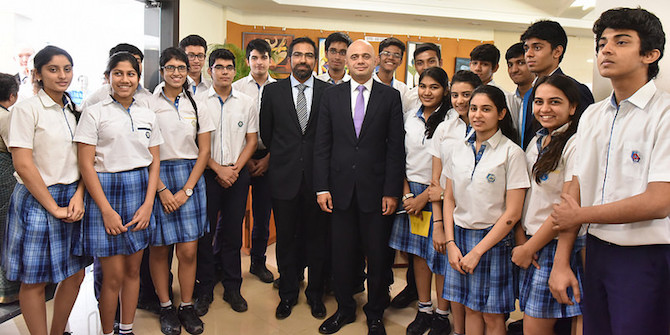Jugaad is a concept that taps into current trends around crafting and thrifting in everyday life. But as the Indian economy grows with an emphasis on innovation, there has been a resurgence of interest in the idea of jugaad. Rina Arya (University of Huddersfield) argues why a broader view of the concept can help illuminate its renewed interest.
‘Jugaad’, a colloquial Hindi word, which approximately translates as ‘quick fix’, ‘workaround’ or ‘hack’, expresses a quintessentially Indian concept, used ubiquitously throughout mainly Northern India. In essence, Jugaad describes a mentality or approach that seeks solutions in adversity, describing how the world is negotiated by improvisation and ingenuity. The word refers to the practice of bending rules and thinking laterally to making something work.
It is a necessity for many Indians at the Bottom of the Pyramid to use a term from economics, for whom access to resources is problematic, and whose socio-economic status makes opportunities for social progression more difficult. For wealthier socio-economic groups, jugaad is employed to reduce expense and economise labour costs (Rai, 2019). But arguably scarcity continues to be prevalent across India and for that reason underpins the approach to jugaad.
The notion of jugaad recently resurfaced in the academy in the context of management studies as a result of the impact of the study Jugaad Innovation: A Frugal and Flexible Approach to Innovation for the 21stCentury (2012) by Radjou et.al, where it was explored as an indispensable part of a toolkit in Indian innovation. Outside of its role in the Indian economy, very little has been written about the cultural resonance of jugaad. So why has this word regained significance in Indian innovation, and what’s its application in everyday India?
Perhaps the best way of understanding the ethos of jugaad is by example and approach. In each case the motivation is always functional and often involves the deployment of objects that have been adapted to fulfil a different function to what they were originally intended, all with the aim of fixing something that was broken or to improve efficiency. Television screens suspended from the ceiling by cables propped up by plastic chairs, saucepans propped up by bottles with lighted candles underneath, handlebars on the back of a cycle being used to carry goods or passengers, the punctured plastic bottle which is used as a shower hose, tiffin boxes tied to a cycle are all typical examples found in households or on the streets. Many instances of jugaad are seen in transport, where a vehicle is reinforced through the addition of cannibalised parts – frames, engines or pumps. Jugaad is seen too in the social realm of everyday activity in interactions that people have with one another, especially with regard to communication with the intent to negotiate, bargain or persuade during sale transactions with the view to saving money. A simple but effective example cited in the literature is the social function of the missed call on a mobile phone as an implicit form of communication.
The solution arrived at in each of these cases is not durable but will have to do for now. It is regarded in its efficiency at that moment – ready-to-hand without concern for future proofing. In their urgency and chalta hai (anything goes) attitude, many examples of jugaad lie outside of the formal economy and on the ‘margins’ of society. This is commonly seen in the way in which unregistered ‘jugaad’ vehicles and are typically without tax insurance. At the more extreme of the spectrum are more overt examples of illegality, such as where intrepid outlaws steal electricity for their villages, out of necessity because they can’t afford it or just because they can get away with it. Whatever might be the motivation, they are putting themselves in potentially fatal situations.
Recent studies in management culture, such as that expounded in Jugaad Innovation, deployed jugaad in examples that take us away from this quick-fix response and that require higher-order thinking and a more permanent solution that can be accused of distorting its focus on the here-and-now essence. The Mitticool clay refrigerator, invented in 2009, and Tata Motor’s Nano car, invented in 2008, fit this description. Both inventions attempted to tackle very real problems faced by India’s population. The refrigerator sought to address the problem of food preservation for rural Indians who do not have access to electricity. Its inventor, Mansukhbhai Prajapati, was motivated by social need. Tata’s ingenious plan (which failed) served to accommodate families in more compact and affordable vehicles, thereby lessening the problem of families travelling in cramped conditions on unsafe and unlicensed makeshift transport. The extent of protracted problem-solving, availability of resources and durability of these examples problematise their conceptualisation as examples of jugaad, even though they strive for core features integral to jugaad, namely frugality and inclusivity. In this similarity yet difference they open up the very important issue of the boundaries of the concept.
Recent interest in jugaad in management culture open up the question of the validity of jugaad when thinking about innovation. There are different aspects to the problem. If we take the etymology literally, and stick to its roots as a particular type of makeshift ingenuity, then anything that involves greater ideation, resource management or complexity falls outside of this definition. But if we take a broader view that incorporates jugaad as a sensibility that is used in innovation then its remit becomes wider. A syncretic perspective accommodates its contradictory aspects. It is at once a strategy for survival for some whilst also being methods or shortcuts for facilitating convenience. It is invites different attitudes – humour, ridicule, incredulity – as evidenced in the multitude of comic visuals (images and videos) circulated on YouTube and social media channels. In contrast to these perceptions, as evidenced in the championing of Indian innovation, it has also become a source of national pride, even though the two might seem to be antithetical. But it has a more serious side. By its place in the margins of the official economy it speaks of the hardship of rural Indians who practice it out of necessity, often endangering themselves and others in the process. Far from being humorous, this conveys the sheer disparity of socio-economic relations in India which make stark the different realities that groups face.
The contrast of perspective, the whole arena of difference that discussion of this compact and complex concept invites necessitates further research, which has all but been outlined here. Jugaad is a concept that taps into current trends around crafting, thrifting. And the growth of the Indian economy, with its emphasis on innovation, and in a high-risk society, summons the need for a resurgence of interest in jugaad.
The author would like to acknowledge Shikhar Patanjali for his insights.
This article gives the views of the author, and not the position of the South Asia @ LSE blog, nor of the London School of Economics. Featured image: Questions image; Credit: jambulboy, Pixabay.







